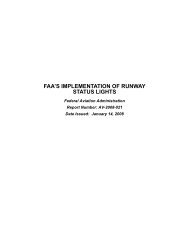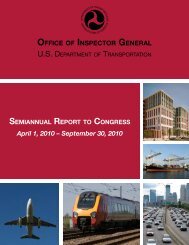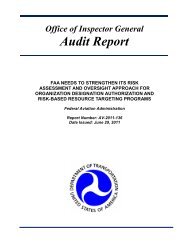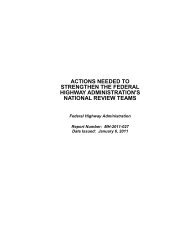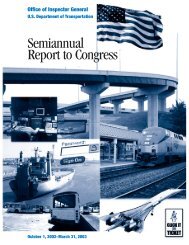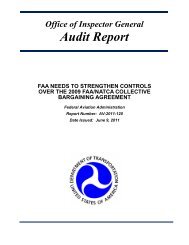Impact Magazine June 2011 - Office of Inspector General - U.S. ...
Impact Magazine June 2011 - Office of Inspector General - U.S. ...
Impact Magazine June 2011 - Office of Inspector General - U.S. ...
You also want an ePaper? Increase the reach of your titles
YUMPU automatically turns print PDFs into web optimized ePapers that Google loves.
a Federal agency other than the one he or she was employed by.<br />
When he questioned Smith about the property request, he said<br />
Smith got “uncomfortable,” so he decided to stop questioning<br />
him and refer the matter to GSA-OIG instead.<br />
The GSA-OIG SAC explained that the excess property<br />
referral system was set up so that Federal agencies can acquire<br />
excess Government-owned property from other agencies. Regulations<br />
require that agencies fll their property needs by using<br />
existing property or by obtaining excess property in lieu <strong>of</strong> new<br />
expenditures or procurements. He said the excess property<br />
system saves taxpayers millions <strong>of</strong> dollars each year. He further<br />
explained that the system was accessed via a GSA-issued<br />
account number and password. When agencies identify a need<br />
for property, they access GSA’s excess property system, known<br />
as GSAXcess, which allows them to search for the item needed.<br />
When they fnd property that meets their needs, they can place a<br />
hold on it, then successfully claim it. The military has a similar<br />
program set up for its excess property, which is distributed<br />
through Defense Reutilization and Marketing Offces (DRMO).<br />
The SAC said he had spoken with Smith’s supervisor,<br />
who advised him that Smith worked as an FAA technician and<br />
was responsible for repairing and maintaining FAA equipment<br />
located in and around San Diego, California. The supervisor said<br />
Smith did not have authority to screen property for FAA, and<br />
there was nothing in his job description that would require him<br />
to obtain excess government equipment. He said he could think<br />
<strong>of</strong> no conceivable reason for Smith to be acquiring excess Federal<br />
property on behalf <strong>of</strong> FAA. He also said that he felt that Smith<br />
was “not an honest employee.” He had to counsel Smith several<br />
times because he believed he was misusing his Government purchase<br />
card.<br />
OIG agreed to work the investigation jointly with GSA-<br />
OIG, and both supervisors assigned two <strong>of</strong> their most seasoned<br />
special agents to look into the matter. The GSA-OIG agent said<br />
he would work with GSA’s property specialist to get information<br />
about the type and amount <strong>of</strong> property Smith allegedly screened.<br />
OIG’s agent agreed to fnd out all he could about Smith, and<br />
determine whether he had authority to screen property for FAA,<br />
MARAD, or any DOT agency. The agents also briefed an Assistant<br />
United States Attorney (AUSA) on the allegations. The<br />
AUSA told the agents that if the allegations about the 44-foot<br />
IMPACT <strong>Magazine</strong> • <strong>June</strong> <strong>2011</strong><br />
EMPLOYEE INTEGRITY INVESTIGATIONS<br />
yacht were true, Smith would be prosecuted for his crimes in the<br />
Western District <strong>of</strong> Washington.<br />
“Now This Is a Kodak Moment!”<br />
OIG agents spoke with Smith’s frst- and second-level<br />
supervisors. They told the agents that Smith had been employed<br />
since the mid 1990s as an FAA airway transportation specialist.<br />
He was responsible for certifying and maintaining FAA equipment<br />
at McClellan-Palomar Airport in Carlsbad, California, but<br />
he was currently working in a 2-month temporary assignment<br />
at FAA’s Regional Offce in Los Angeles. His supervisors again<br />
confrmed that Smith had no authority to screen property on<br />
behalf <strong>of</strong> FAA. The agent also checked with MARAD’s property<br />
screener who confrmed that Smith did not have authority to<br />
screen excess property for MARAD.<br />
GSA-OIG conducted a review <strong>of</strong> its records and determined<br />
that since 2004, Smith had been stealing Government<br />
excess property by illegally using MARAD and FAA property<br />
screening account codes. GSA-OIG’s agent also determined that<br />
Smith had most recently screened the U.S. Naval Sailing Yacht<br />
commissioned “The Lively,” which was moored at a marina on<br />
Seattle’s Elliott Bay. The Lively was a 44-foot yacht that was used<br />
by the University <strong>of</strong> Washington’s Navy ROTC as a training vessel.<br />
According to GSA’s property specialist, Smith gave him the<br />
necessary documents to have the yacht released from DRMO to<br />
MARAD.<br />
The agents met with the harbor master at the marina<br />
on Elliott Bay where The Lively was moored. The harbor master<br />
told them he’d spoken with Smith, who had called him to arrange<br />
for a time he could pick up the yacht. He said that Smith<br />
had told him he was with DOT and that MARAD would be<br />
sharing use <strong>of</strong> The Lively with a nonpr<strong>of</strong>t organization that <strong>of</strong>fered<br />
sailing lessons to disadvantaged teenagers. He also told the<br />
harbor master that he might be sending a representative to pick<br />
up the vessel instead <strong>of</strong> picking it up himself.<br />
The agents decided to conduct surveillance to see if<br />
Smith would actually steal a 44-foot yacht. They contacted an<br />
agent from NCIS, who joined the investigative team. When the<br />
FBI was notifed about the investigation, it also assigned an agent<br />
to assist. OIG’s agent remained in close contact with Smith’s<br />
supervisors to fnd out when he scheduled annual or sick leave.<br />
23



